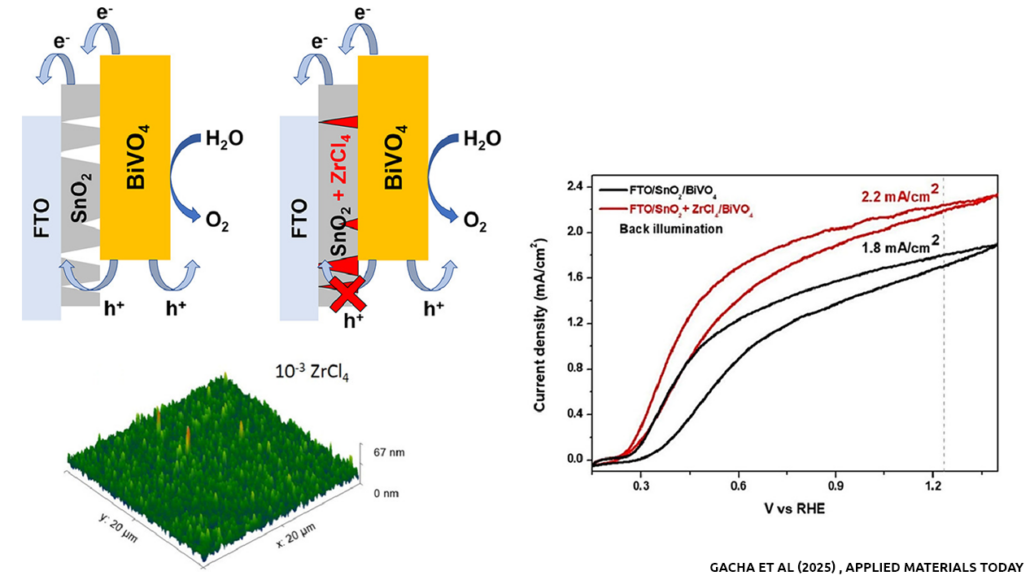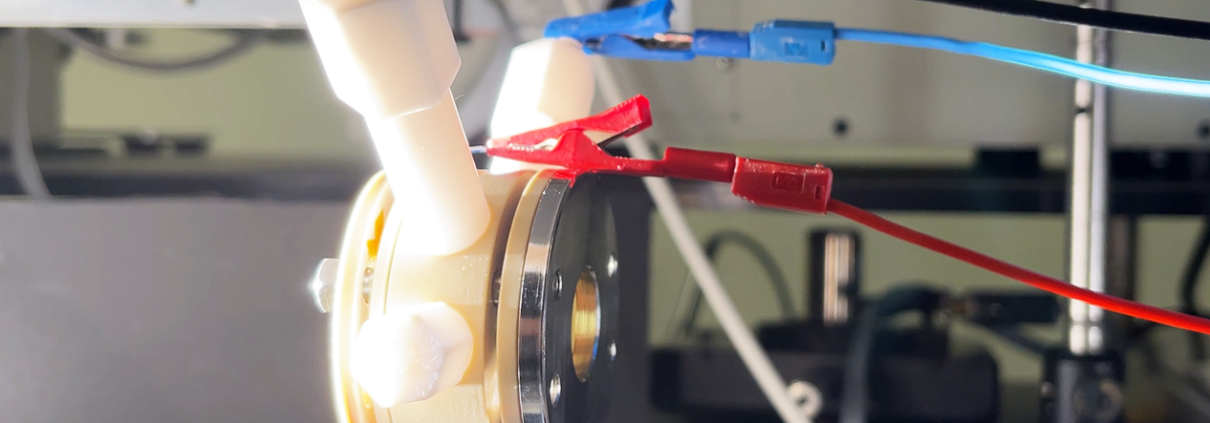SOREC2 researchers develop a novel passivation technique to improve BiVO4’s photoanodes efficiency
A team of researchers, including SOREC2 team members, have developed a new way to improve the efficiency of bismuth vanadate photoanodes for their use in photoelectrochemical systems for water oxidation. In a new study, published in the journal Applied Materials Today, the researchers describe the implementation for the first time of a passivation layer in BiVO4 photoanodes, achieving a 37% improvement in photocurrent density compared to standard bare BiVO4 photoanodes.
Photoelectrochemical (PEC) water splitting offers a promising way to produce hydrogen and oxygen from water, or to convert CO2 into valuable chemicals, using sunlight. Photoanodes, key multi-layered components in these systems, absorb sunlight and use the energy to split water and reduce CO2. Bismuth vanadate (BiVO4) is a promising photoanode material because it has the adequate band gap and good stability.
However, BiVO4 has some limitations. Electron-hole pairs recombine too readily on the surface, and charge transport is poor, reducing efficiency of the devices. To address these issues, tin oxide (SnO2) films are often used as an electron transport layer (ETL) between the BiVO4 and fluorine-doped tin oxide (FTO) substrates. This helps to create high-performance BiVO4 photoanodes by reducing recombination and improving the charge extraction process. However, this method isn’t perfect. Defects at the SnO2/ BiVO4 interface and small opening (pinholes) in the SnO2 layer can still cause some problems.

Scheme depicting the role of ZrCl4 incorporation into the photoanodes.
Now researchers from the SOREC2 project, including Valentina Gacha, Carles Ros, Jordi Martorell, and Dimitrios Raptis from ICFO, and collaborators from the Universitat Politècnica de Catalunya (UPC), have developed a new method to improve the efficiency of BiVO4 photoanodes for PEC water splitting. They have implemented for the first time a metal chloride passivation layer to boost the BiVO4 photocurrent density. The researchers described the new technique in a paper published in the journal Applied Materials Today.
In their study, the researchers used a Zirconium Tetrachloride (ZrCl4) solution to treat the SnO2 layer, a technique that had been used before to reduce surface traps and charge recombination in perovskite solar cells. “We hypothesized that a similar strategy could improve BiVO4 photoanodes,” says Valentina Gacha, ICFO researcher and first author of the study. “Our results confirm this, showing the potential of material engineering to address long-standing challenges in photoanode performance.”
ZrCl4 treatment enhances charge transport and photocurrent density
The researchers fabricated BiVO4 photoanodes on fluorine-doped tin oxide (FTO) substrates, covering it with a SnO2 layer, covered with a spin-coated ZrCl4 solution. Finally, they deposited and crystallized a BiVO4 90nm layer on top of the treated SnO2.
The researchers analysed the fabricated photoanode samples to study its morphology, chemical composition and optical properties. Finally, they studied the charge transport and separation capabilities of the layer treated with metal chloride and found that the ZrCl4 treatment smoothed the SnO2 layer, improving the charge transport within the BiVO4 layer. “This smoothing effect creates a flatter surface, helping the BiVO4grow evenly and also prevents direct contact between the FTO substrate and the semiconductor material,” noted Valentina Gacha.
According to the study, the ZrCl4 treatment significantly improved the BiVO4 photoanodes’ efficiency. The treated photoanodes showed a 37% increase in photocurrent density at 1.23 V vs. RHE under front illumination compared to untreated photoanodes. The researchers also found that the low concentration ZrCl4 solution on the SnO2 improved the FTO electrode’s coverage and reduced charge recombination.
“It is important to note that the implemented treatment does not alter any intrinsic electronic properties of BiVO4.” said Valentina Gacha. ” The ZrCl4 maintains the bandgap of the bare bismuth vanadate and enhances at the same time the photocurrent density by improving charge extraction efficiency”.
The researchers now aim to further improve the photoanode’s efficiency using an optical approach. “While material engineering has already significantly boosted performance, we’re now exploring optical methods to further enhance the BiVO4 photoanodes’ efficiency,” says Valentina Gacha.
Original article
Valentina Gacha, Carles Ros, Xènia Garcia, Jordi Llorca, Jordi Martorell, Dimitrios Raptis (2024) Enhancing charge extraction in BiVo4 photoanodes by ZrCl4 treatment of SnO2 hole blocking layers. Applied Materials Today. Doi: https://doi.org/10.1016/j.apmt.2024.102415




